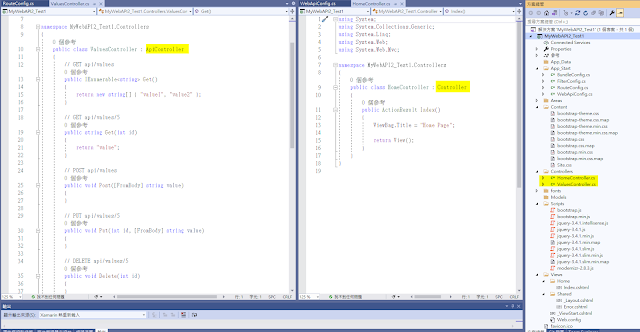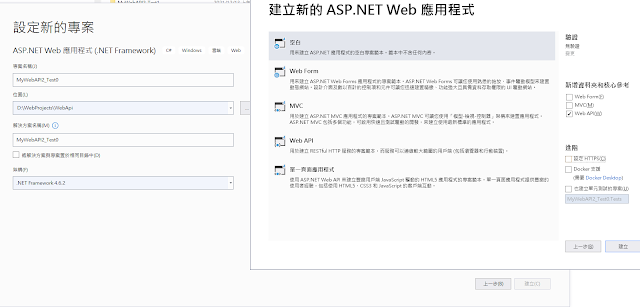ASP.NET WebAPI2第003天_MVC專案及WebAPI專案比較_PostMan模擬各種HTTPVerbs呼叫操作與常見status code分類
Web API 專案建立方式
第一種.預設產生範本(會強制一併勾選MVC)
記得將解決方案與專案置於相同目錄中要取消勾選
預設產生的專案目錄與檔案結構如下
可以看到有分為MVC控制器跟API控制器
路由部分傳統大宗路由設置
也有分為MVC路由(~\App_Start\RouteConfig.cs)
using System;
using System.Collections.Generic;
using System.Linq;
using System.Web;
using System.Web.Mvc;
using System.Web.Routing;
namespace MyWebAPI2_Test1
{
public class RouteConfig
{
public static void RegisterRoutes(RouteCollection routes)
{
routes.IgnoreRoute("{resource}.axd/{*pathInfo}");
routes.MapRoute(
name: "Default",
url: "{controller}/{action}/{id}",
defaults: new { controller = "Home", action = "Index", id = UrlParameter.Optional }
);
}
}
}
跟WebAPI路由(~\App_Start\WebApiConfig.cs)
using System;
using System.Collections.Generic;
using System.Linq;
using System.Web.Http;
namespace MyWebAPI2_Test1
{
public static class WebApiConfig
{
public static void Register(HttpConfiguration config)
{
// Web API 設定和服務
// Web API 路由
config.MapHttpAttributeRoutes();
config.Routes.MapHttpRoute(
name: "DefaultApi",
routeTemplate: "api/{controller}/{id}",
defaults: new { id = RouteParameter.Optional }
);
}
}
}
第二種.產生空專案選用WEBAPI方式
這邊新建一個API控制器(具有讀寫動作)
在Models新建一個Product class
1 2 3 4 5 6 7 8 9 10 11 12 13 14 | using System; using System.Collections.Generic; using System.Linq; using System.Web; namespace MyWebAPI2_Test0.Models { public class Product { public int Id { get; set; } public string ProductName { get; set; } public decimal Price { get; set; } } } |
ProductsController.cs中改寫產品的增刪改查程式
1 2 3 4 5 6 7 8 9 10 11 12 13 14 15 16 17 18 19 20 21 22 23 24 25 26 27 28 29 30 31 32 33 34 35 36 37 38 39 40 41 42 43 44 45 46 47 48 49 50 51 52 53 54 55 56 57 | using MyWebAPI2_Test0.Models; using System; using System.Collections.Generic; using System.Linq; using System.Net; using System.Net.Http; using System.Web.Http; namespace MyWebAPI2_Test0.Controllers { public class ProductsController : ApiController { static List<Product> products = new List<Product>() { new Product(){Id = 0,ProductName = "Apple",Price = 20}, new Product(){Id = 1,ProductName = "Banana",Price = 40}, new Product(){Id = 2,ProductName = "Orange",Price = 60} }; // GET: api/Products [HttpGet] public IHttpActionResult LoadProducts() { return Ok(products); } // GET: api/Products/5 [HttpGet] public Product GetSpecificProduct(int id) { return products[id]; } // POST: api/Products [HttpPost] public HttpResponseMessage Post([FromBody] Product product) { products.Add(product); return new HttpResponseMessage(HttpStatusCode.Created); } // PUT: api/Products/5 [HttpPut] public void Put([FromUri] int id, [FromBody] Product product) { products[id] = product; } // DELETE: api/Products/5 [HttpDelete] public void Delete(int id) { products.RemoveAt(id); } } } |
HTTPVerbs
| Function | URI | Http Method | HTTP StatusCode |
| 新增 | /products | POST | 201,400,401,409,500 |
| 修改 | /products/{id} | PUT | 204,400,401,404,409,500 |
| 刪除 | /products/{id} | Delete | 204,400,401,404,409,500 |
| 查詢 | /products/{id} | Get | 200,400,401,409,500 |
| 清單 | /products | Get | 200,400,401,409,500 |
先將Web API RUN起來模擬已經Host在本機
在我們的Postman軟體中來做一些模擬測試
Get 清單
Get 特定一筆
POST 新增一筆
PUT 修改更新特定某一筆
比方芒果價格帳價要改成90
品種名稱改愛文芒果
DELETE 刪除特定某一筆
其中一些Status Code區別
一般單筆查詢或者清單查詢皆為200 OK
void主要都回傳 204 No Content
而POST則是 201 Created
一般Status Code可以區分5大類
常見的500開頭系列絕大部分屬於Server-Side異常(可能程式異常或環境問題)
500 - Internal Server Error A 500 status code (all too often seen by Perl programmers) indicates that the server encountered something it didn't expect and was unable to complete the request.
501 - Not Implemented The 501 status code indicates that the server does not support all that is needed for the request to be completed.
502 - Bad Gateway A 502 status code indicates that a server, while acting as a proxy, received a response from a server further upstream that it judged invalid.
503 - Service Unavailable A 503 status code is most often seen on extremely busy servers, and it indicates that the server was unable to complete the request due to a server overload.
504 - Gateway Timeout A 504 status code is returned when a server acting as a proxy has waited too long for a response from a server further upstream.
505 - HTTP Version Not Supported A 505 status code is returned when the HTTP version indicated in the request is no supported. The response should indicate which HTTP versions are supported.
400開頭系列大部分屬於Client-Side異常
400 - Bad Request A status code of 400 indicates that the server did not understand the request due to bad syntax.
401 - Unauthorized A 401 status code indicates that before a resource can be accessed, the client must be authorised by the server.
402 - Payment Required The 402 status code is not currently in use, being listed as "reserved for future use".
403 - Forbidden A 403 status code indicates that the client cannot access the requested resource. That might mean that the wrong username and password were sent in the request, or that the permissions on the server do not allow what was being asked.
404 - Not Found The best known of them all, the 404 status code indicates that the requested resource was not found at the URL given, and the server has no idea how long for.
405 - Method Not Allowed A 405 status code is returned when the client has tried to use a request method that the server does not allow. Request methods that are allowed should be sent with the response (common request methods are POST and GET).
406 - Not Acceptable The 406 status code means that, although the server understood and processed the request, the response is of a form the client cannot understand. A client sends, as part of a request, headers indicating what types of data it can use, and a 406 error is returned when the response is of a type not i that list.
407 - Proxy Authentication Required The 407 status code is very similar to the 401 status code, and means that the client must be authorised by the proxy before the request can proceed.
408 - Request Timeout A 408 status code means that the client did not produce a request quickly enough. A server is set to only wait a certain amount of time for responses from clients, and a 408 status code indicates that time has passed.
409 - Conflict A 409 status code indicates that the server was unable to complete the request, often because a file would need to be editted, created or deleted, and that file cannot be editted, created or deleted.
410 - Gone A 410 status code is the 404's lesser known cousin. It indicates that a resource has permanently gone (a 404 status code gives no indication if a resource has gine permanently or temporarily), and no new address is known for it.
411 - Length Required The 411 status code occurs when a server refuses to process a request because a content length was not specified.
412 - Precondition Failed A 412 status code indicates that one of the conditions the request was made under has failed.
413 - Request Entity Too Large The 413 status code indicates that the request was larger than the server is able to handle, either due to physical constraints or to settings. Usually, this occurs when a file is sent using the POST method from a form, and the file is larger than the maximum size allowed in the server settings.
414 - Request-URI Too Long The 414 status code indicates the the URL requested by the client was longer than it can process.
415 - Unsupported Media Type A 415 status code is returned by a server to indicate that part of the request was in an unsupported format.
416 - Requested Range Not Satisfiable A 416 status code indicates that the server was unable to fulfill the request. This may be, for example, because the client asked for the 800th-900th bytes of a document, but the document was only 200 bytes long.
417 - Expectation Failed The 417 status code means that the server was unable to properly complete the request. One of the headers sent to the server, the "Expect" header, indicated an expectation the server could not meet.
300開頭系列多半屬於發生在Redirection
300 - Multiple Choices The 300 status code indicates that a resource has moved. The response will also include a list of locations from which the user agent can select the most appropriate.
301 - Moved Permanently A status code of 301 tells a client that the resource they asked for has permanently moved to a new location. The response should also include this location. It tells the client to use the new URL the next time it wants to fetch the same resource.
302 - Found A status code of 302 tells a client that the resource they asked for has temporarily moved to a new location. The response should also include this location. It tells the client that it should carry on using the same URL to access this resource.
303 - See Other A 303 status code indicates that the response to the request can be found at the specified URL, and should be retrieved from there. It does not mean that something has moved - it is simply specifying the address at which the response to the request can be found.
304 - Not Modified The 304 status code is sent in response to a request (for a document) that asked for the document only if it was newer than the one the client already had. Normally, when a document is cached, the date it was cached is stored. The next time the document is viewed, the client asks the server if the document has changed. If not, the client just reloads the document from the cache.
305 - Use Proxy A 305 status code tells the client that the requested resource has to be reached through a proxy, which will be specified in the response.
307 - Temporary Redirect 307 is the status code that is sent when a document is temporarily available at a different URL, which is also returned. There is very little difference between a 302 status code and a 307 status code. 307 was created as another, less ambiguous, version of the 302 status code.
200開頭系列則屬於Success性質的回應
200 - OK The 200 status code is by far the most common returned. It means, simply, that the request was received and understood and is being processed.
201 - Created A 201 status code indicates that a request was successful and as a result, a resource has been created (for example a new page).
202 - Accepted The status code 202 indicates that server has received and understood the request, and that it has been accepted for processing, although it may not be processed immediately.
203 - Non-Authoritative Information A 203 status code means that the request was received and understood, and that information sent back about the response is from a third party, rather than the original server. This is virtually identical in meaning to a 200 status code.
204 - No Content The 204 status code means that the request was received and understood, but that there is no need to send any data back.
205 - Reset Content The 205 status code is a request from the server to the client to reset the document from which the original request was sent. For example, if a user fills out a form, and submits it, a status code of 205 means the server is asking the browser to clear the form.
206 - Partial Content A status code of 206 is a response to a request for part of a document. This is used by advanced caching tools, when a user agent requests only a small part of a page, and just that section is returned.
100系列則比較少見的資訊回應
100 - Continue A status code of 100 indicates that (usually the first) part of a request has been received without any problems, and that the rest of the request should now be sent.
101 - Switching Protocols HTTP 1.1 is just one type of protocol for transferring data on the web, and a status code of 101 indicates that the server is changing to the protocol it defines in the "Upgrade" header it returns to the client. For example, when requesting a page, a browser might receive a statis code of 101, followed by an "Upgrade" header showing that the server is changing to a different version of HTTP.
Ref:




















留言
張貼留言